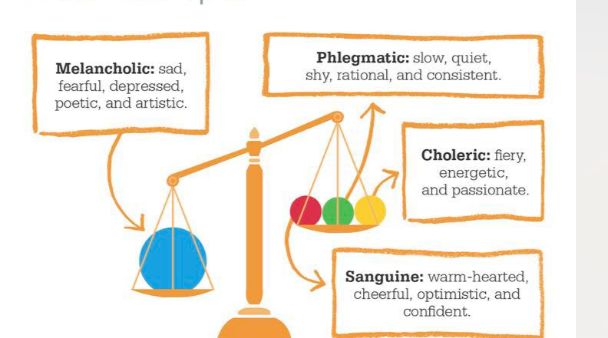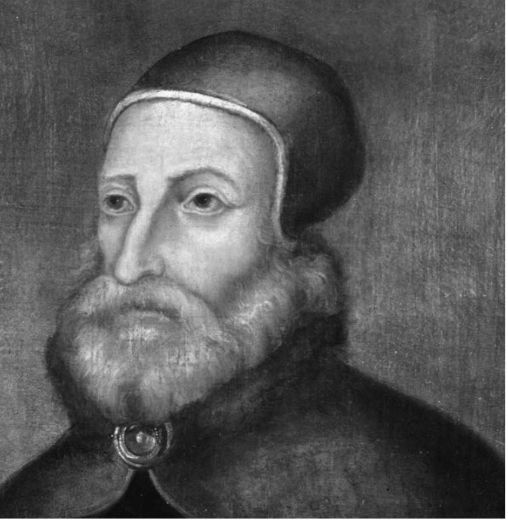作者 简单的镜子
转载请标明原作者和出处
也可以关注我的
The Four Temperaments Of Personal
The Roman philosopher and physician Claudius Galen formulated a concept of personality types based on the ancient Greek theory of humourism(体液学说), which attempted to explain the workings of the human body.The roots of humourism go back to Empedocles (c.495–435 BCE), a Greek philosopher who suggested that different qualities of the four basic elements – earth (cold and dry), air (warm and wet), fire (warm and dry), and water (cold and wet) – could explain the existence of all known substances.
Hippocrates (460–370 BCE), the “Father of Medicine”, developed a medical model based on these elements, attributing their qualities to four fluids within the body. These fluids were called “humours(体液)” (from the Latin umor, meaning body fluid). Two hundred years later, Galen expanded the theory of humourism into one of personality; he saw a direct connection between the levels of the humours in the body and emotional and behavioural inclinations – or “temperaments”. Galen’s four temperaments – sanguine(多血质的), phlegmatic(黏液质的), choleric(胆汁质的), and melancholic – are based on the balance of humours in the body. If one of the humours develops excessively, the corresponding personality type begins to dominate.
A sanguine person has too much blood (sanguis in Latin) and is warm-hearted, cheerful, optimistic, and confident, but can be selfish. A phlegmatic person, suffering from excess phlegm(黏液) (phlegmatikósin Greek), is quiet, kind, cool, rational, and consistent(坚持的), but can be slow and shy. The choleric (from the Greek kholé, meaning bile) personality is fiery(易怒的), suffering from excess yellow bile. Lastly, the melancholic (from the Greek melas kholé), who suffers from an excess of black bile, is recognized by poetic and artistic leanings, which are often also accompanied by sadness and fear.
Imbalance in the humours According to Galen, some people are born predisposed to(更倾向于) certain temperaments. However, since temperamental problems are caused by imbalances of the humours, he claimed they can be cured by diet and exercise. In more extreme cases, cures may include purging(通便) and blood-letting. For example, a person acting selfishly is overly sanguine, and has too much blood; this is remedied by cutting down on meat, or by making small cuts into the veins to release blood.
Galen’s doctrines dominated medicine until the Renaissance, when they began to decline in the light of better research. In 1543, the physician Andreas Vesalius (1514–1564), practising in Italy, found more than 200 errors in Galen’s descriptions of anatomy, but although Galen’s medical ideas were discredited, he later influenced 20th-century psychologists. In 1947, Hans Eysenck concluded that temperament is biologically based, and noted that the two personality traits he identified – neuroticism(神经质) and extraversion(外向性) – echoed the ancient temperaments.Although humourism is no longer part of psychology, Galen’s idea that many physical and mental illnesses are connected forms the basis of some modern therapies.
Imbalances in the humours determine personality type as well as inclinations towards certain illnesses.
MORE TO KNOW…
APPROACH
Humourism
BEFORE
c.400 BCE Greek physician Hippocrates says that the qualities of the four elements are reflected in body fluids.
c.325 BCE Greek philosopher Aristotle names four sources of happiness: sensual(感官的) (hedone), material (propraietari), ethical (ethikos), and logical (dialogike).
AFTER
1543 Anatomist Andreas Vesalius publishes On the Fabric of the Human Body in Italy. It illustrates Galen’s errors and he is accused of heresy(异端).
1879 Wilhelm Wundt says that temperaments develop in different proportions along two axes: “changeability(可变性)” and “emotionality(情绪性)”.
1947 In Dimensions of Personality, Hans Eysenck suggests personality is based on two dimensions.
GALEN
Claudius Galenus, better known as “Galen of Pergamon” (now Bergama in Turkey) was a Roman physician, surgeon, and philosopher. His father, Aelius Nicon, was a wealthy Greek architect who provided him with a good education and opportunities to travel. Galen settled in Rome and served emperors, including Marcus Aurelius, as principal physician. He learned about trauma care while treating professional gladiators(角斗士), and wrote more than 500 books on medicine.
He believed the best way to learn was through dissecting(解剖) animals and studying anatomy. However, although Galen discovered the functions of many internal organs, he made mistakes because he assumed that the bodies of animals (such as monkeys and pigs) were exactly like those of humans. There is debate over the date of his death, but Galen was at least 70 when he died.
Key works
c.190 CE The Temperaments
c.190 CE The Natural Faculties
c.190 CE Three Treatises on the Nature of Science
以下是我写的关于The Psychology Book的其他章节,欢迎各位前来观看 ^ ^


